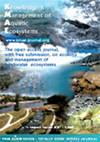大型无脊椎动物定殖与本地和入侵凋落叶分解有关
IF 1.7
3区 环境科学与生态学
Q3 FISHERIES
引用次数: 11
摘要
湖泊和水库生态系统被视为以碎屑为基础的异养生境,其大部分能量输入都依赖于原生和外来有机质。特别是,外来碎屑对淡水中微生物、大型无脊椎动物和底栖植物的营养动力学特别重要。在这里,我们评估了大型无脊椎动物的定殖,并量化了小型农业水库中本地和入侵植物的凋落叶的分解率。将本地无花果无花果(Ficus sycomorus)和银簇叶Terminalia sericea与入侵的山莓(Lantana camara)和番石榴(Psidium guajava)进行了比较,从而评估了大型无脊椎动物随时间的定植。叶片处理对局灶大型无脊椎动物的丰度和组成有显著的群体特异性影响。入侵叶片降低了藻科和寡毛纲的丰度,而介形虫科的丰度显著高于入侵瓜爪牙。不同叶片处理对蠓科相对丰度的影响差异无统计学意义。大型无脊椎动物多样性在不同植物处理组间无显著差异。凋落叶的分解速率在不同树种间存在差异,依次为L. camara b> . sycomorus b> . sericea b> . guajava。研究结果表明,入侵植物和本地植物凋落叶的物种识别在大型无脊椎动物在小型水库中的定殖中起着重要作用,从而对水生环境和食物网提供不同的支持。然而,在不同的入侵-本地群体中,差异并不一致。尽管如此,某些入侵凋落叶比本地凋落叶分解得更快,这可能对更广泛的营养动态和随后的群落组成产生影响。本文章由计算机程序翻译,如有差异,请以英文原文为准。
Macroinvertebrate colonisation associated with native and invasive leaf litter decomposition
Lake and reservoir ecosystems are regarded as heterotrophic detritus-based habitats which are dependent on both autochthonous and allochthonous organic matter for the majority of energy inputs. In particular, allochthonous detritus is in particular important for the trophic dynamics of microbial organisms, macroinvertebrates and benthic plants in freshwaters. Here, we assess macroinvertebrate colonisation, and quantify decomposition rates, of leaf litter from species of native and invasive plants in a small agricultural reservoir. Native fig Ficus sycomorus and silver cluster–leaf Terminalia sericea were compared to invasive tickberry Lantana camara and guava Psidium guajava, whereby macroinvertebrate colonisation was assessed over time. Leaf treatments had a significant, group-specific effect on abundances and composition among focal macroinvertebrates. Invasive leaves reduced Physidae and Oligochaeta abundances, yet Ostracoda were significantly more abundant in the presence of invasive P. guajava. Chironomidae relative abundances increased under invasive L. camara treatments, whilst differences among leaf treatment effects on Coenogrionidae abundances were not statistically clear. In turn, macroinvertebrate diversity did not differ significantly among plant treatment groups. The decomposition rate of the leaf litter demonstrated differences among the species, following a decreasing order of L. camara > F. sycomorus > T. sericea > P. guajava. The study results highlight that leaf litter species identity among invasive and native plants plays an important role in the colonisation of macroinvertebrates in small reservoirs, thereby differentially supporting aquatic environments and food webs. However, differences were not uniform across invader-native groupings. Nonetheless, certain invasive leaf litter decomposes faster than native litter, with possible implications for broader nutrient dynamics and subsequent community composition.
求助全文
通过发布文献求助,成功后即可免费获取论文全文。
去求助
来源期刊

Knowledge and Management of Aquatic Ecosystems
环境科学-海洋与淡水生物学
CiteScore
3.70
自引率
5.60%
发文量
22
审稿时长
>12 weeks
期刊介绍:
Knowledge and Management of Aquatic Ecosystems (KMAE-Bulletin Français de la Pêche et de la Pisciculture since 1928) serves as a foundation for scientific advice across the broad spectrum of management and conservation issues related to freshwater ecosystems.
The journal publishes articles, short communications, reviews, comments and replies that contribute to a scientific understanding of freshwater ecosystems and the impact of human activities upon these systems. Its scope includes economic, social, and public administration studies, in so far as they are directly concerned with the management of freshwater ecosystems (e.g. European Water Framework Directive, USA Clean Water Act, Canadian Water Quality Guidelines, …) and prove of general interest to freshwater specialists. Papers on insular freshwater ecosystems and on transitional waters are welcome. KMAE is not a preferred journal for taxonomical, physiological, biological, toxicological studies, unless a clear link to ecological aspects can be established. Articles with a very descriptive content can be accepted if they are part of a broader ecological context.
 求助内容:
求助内容: 应助结果提醒方式:
应助结果提醒方式:


